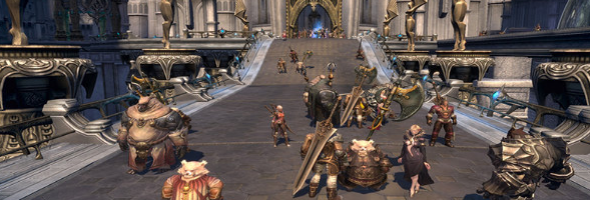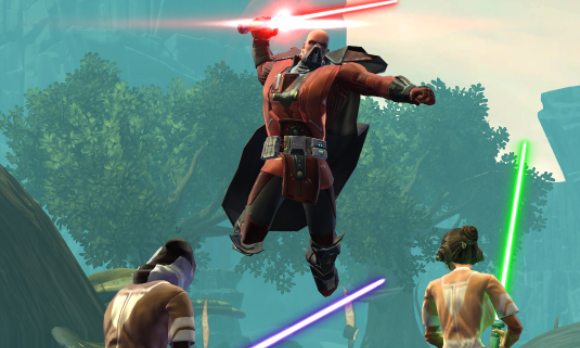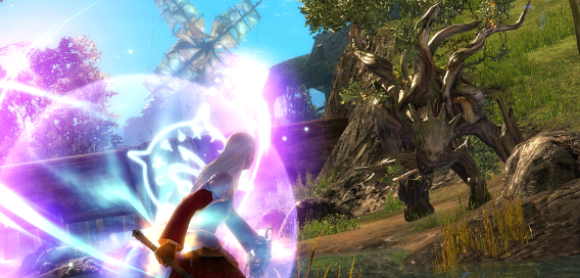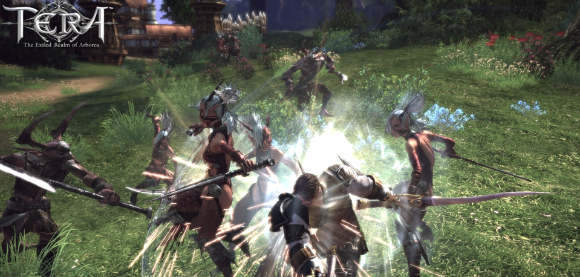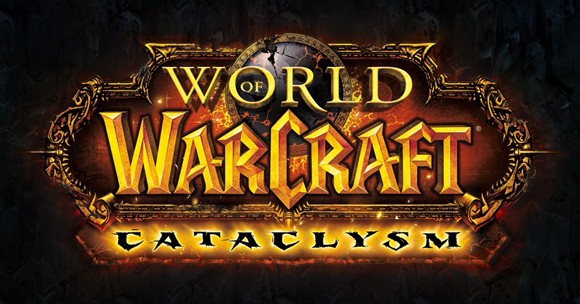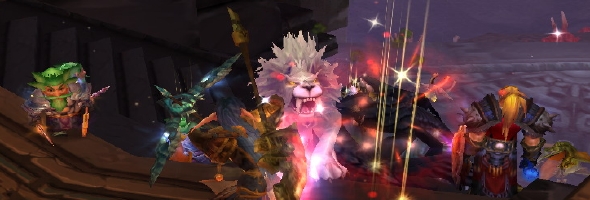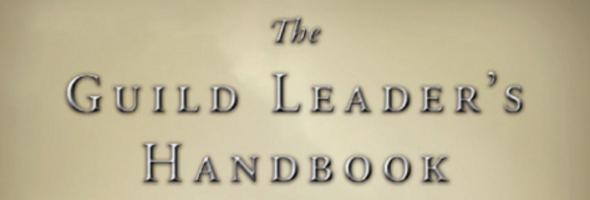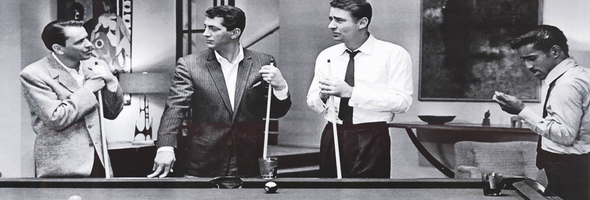Cataclysm is rapidly approaching and the game world we’ve known for the last 5+ years is changing. Towns destroyed, new races about and new powers for each race to play with. WoW is not the only game facing changes though, In fact the state of MMOs is changing as a whole, I mean let’s face it, in the coming months everything we thought we knew about this genre is going to go right out the window. The best part is, we as gamers are in the right place to enjoy the best of these changes to come … hopefully. You may ask yourself what am I talking about? Well let’s take a look at things that are going to be happening in the very near future.
One of the most highly anticipated games coming up is Star Wars: The Old Republic (SWTOR). The game takes a popular franchise and is recreating the universe for a new MMO. So far it is shaping up to bring some new features with.
Every NPC / Quest is voiced: That is right, talk to an npc to get a quest, the whole thing will be read off to you by the character audibly. Pretty massive undertaking, and a pretty cool feature.
Consequence system: Every choice you make in the game, every quest you take every mob you kill has consequences. It can alter what quests you have available to you as well as what powers become available to you. It is possible to play two different characters and get completely different experiences based purely on the choices you make. The other part that is interesting about this MMO is that your choices can lead to faction changing. It has been stated that a Sith can be redeemed and a Jedi can fall from grace, all based on the choices you make in the game world.
Advanced Class system: Each starting class can evolve into one of two advanced classes, each of those advanced classes has two skill trees it can choose from. This allows for a large variation among players and classes and lets you customize your character to suit your needs and play-style. The depth of this is not yet revealed but this can be very very interesting in the future of updating and personalizing your in game avatars.
A Whole Universe to Explore: Most MMOs take place on a comparatively small land mass or group of landmasses (EvE online is an exception here), and can often times feel very linear in its progression. This is a truly massive undertaking as they are creating many many worlds for us to explore and each world is to be massive in and of themselves. The sheer scope of this, and the potential for player freedom here can be an altering factor to MMOs to come after.
These are just things off the top of my head about the game, there will be more to come as the game is closer to release, but they are truly beginning to push away from MMOs as we know them.
Guild Wars received great attention when it was released 5 years ago in part because it was a free to play after you purchased the game, but also because it was (and still is) a good game. The sequel is shaping up to be even bigger and badder than the original (which is a good thing), but like Bioware with SWOTR, Arenanet aiming to shake things up a bit.
Whole New Way to Quest: I’ll open this up with a quote from Colin Johanson, Lead Content Designer for Guild Wars 2.
When building an MMO, we had to examine every core piece of accepted content from traditional games in the genre and ask, “How can this be improved?” By looking at the traditional quest system used in basically every MMO ever made, we’ve come to the conclusion that quests have a lot of areas for improvement. To address these flaws, we’ve developed our dynamic event system.
Traditional quest systems involve walking up to a character who usually has an exclamation point or question mark hovering over their head and talking to them. From here, you get a massive wall of text hardly anyone reads that describes a horrible or totally mundane thing going on in the world that you need to help with. You run off, complete this task, then return and talk to this character again to receive another wall of text and a reward. Traditional quest systems rely on these blocks of quest text to tell you what is happening in the world; this is just an outdated form of storytelling.
In Guild Wars 2, our event system won’t make you read a huge quest description to find out what’s going on. You’ll experience it by seeing and hearing things in the world. If a dragon is attacking, you won’t read three paragraphs telling you about it, you’ll see buildings exploding in giant balls of fire, and hear characters in the game world screaming about a dragon attack. You’ll hear guards from nearby cities trying to recruit players to go help fight the dragon, and see huge clouds of smoke in the distance, rising from the village under siege.
That is fairly massive right there, I mean just think about that. Total immersion into the world. That is pretty impressive and really sells the world to the players. He goes on to say the following
There is a second fundamental flaw to traditional quest systems: what the quest text tells you is happening in a quest is not actually what is happening in the world.
For example, in a traditional MMO, the character who gives you a quest will tell you ogres are coming to destroy the character’s home, and you need to kill them. You then get a quest which says, “Kill 0/10 ogres” and you proceed to kill a bunch of ogres standing around in a field picking daisies. Since every player in the game needs to be able to do this quest, the ogres will never actually threaten the character’s home – they will just eternally pick daisies in the field. The ogres aren’t actually doing what the quest says they are – the game is lying to you!
At ArenaNet, we believe this is NOT good enough. In Guild Wars 2, if a character tells you ogres are coming to destroy a house, they will really come and smash down the house if you don’t stop them!
We’ve all seen it, we get the quest to go kill x of y because they are coming to hurt z, but in truth they are just standing around doing nothing but waiting for the players to come and kill them. This adds a real consequence to the game world and leads into the second big thing about the game.
A Living Breathing World: Every action you take has an effect on the world around you. This means if you don’t stop the ogres from destroying that home, guess what? The building is actually destroyed and gone. If an army lays siege to a town and takes it, they will occupy that town, until someone frees the town from the army. There is no case of say a certain inn in a certain western location being built for 5+ years. If a city or town gets decimated it is not outside of reason that in this game it will be rebuilt over time. Traditionally in MMOs once you complete a quest or a task, you collect your reward and you move on with no effect on the world (That damn Corki keeps getting caught by the Ogres…), here everything you choose to do — or that which you choose not to do — has an impact on the world around you and can cause a chain of events that you may not see happen from making one innocuous choice.
Bringing a Community Back to MMOs: Right now in most games if a player goes off to kill a named NPC and another player gets the same quest, unless they are in the same group together they have to wait for the mob to respawn. This has often let to things such as griefing and harassment. Arenanet aims to end that. I’ll end my section here with one more quote
All players that fully participate in an event are rewarded for doing so; everyone who helps kill a monster or blow up an enemy catapult will get credit for doing so. There is no kill stealing and no quest camping. Everyone works together towards the common goal of the event and everyone is rewarded for doing so. To help ensure there is always enough for everyone to do, our events dynamically scale, so the more players who show up and participate in the event, the more enemies show up to fight them. If a bunch of players leave the event, it will dynamically scale back down so it can be completed by the people who are still there playing it. This careful balance created by our dynamic scaling system helps ensure you have the best and most rewarding play experience.
Tell me that doesn’t sound pretty cool. Again this can help shape how players move and interact through MMOs to come, depending entirely on execution of course.
Tera: The Exiled Realms of Arborea
Recently I had the good fortune to speak with Producer Brian Knox and writer Robin MacPherson from En Masse Entertainment on the podcast. If you’re interested you can click here for the show notes and the episode is free for download on iTunes or direct link from the site. The information we gained from the interview is pretty killer. The game itself is being simultaneously developed for both the eastern and western markets. There has been some trouble bringing eastern games over to the west based purely upon the different ideas of what we want in a game. En Masse aims to not only break those barriers but redefine the MMOs while they do it. So what do they have in store for us?
Define Your Own Player Relations: As of now there are no factions like we are used to in World of Warcraft and other games, instead it is entirely up to a player to choose who they side with. You choose your allies and your enemies. There is no pre-set racial enmity so you have complete freedom here. This is kind of a big deal for some people, and hasn’t really been seen since the days of Star Wars Galaxies. Yes there is PvP in the game, but it is about groups and teams versus other groups and teams. It is very likely that at some point you will be facing off against members of your own race in gladiatorial combat! It really opens up a lot of opportunities for the players both in terms of the game and, if they so choose, role playing.
Combat and Healing: The developers of Tera aim to make a much more involved combat system. There are no auto attacks here, there are no infinite stun locks, Tera’s tactical combat system gives players more control and constant involvement in the the game-play. No more point-and-click or just cycling through a palette of spells and skills, you really have to pay attention. This is not only true for damage dealers, but also for healers. They gave us two great examples on the show. One of their healers has a multiple target heal, it is activated by the player and held, the player is then required to select the target of the heals by clicking on them and then releasing the heal. Another can drop a series of orbs that will be used to heal players as they move around, requiring tactical placement and attention to the fight. They also are working to not make healers so fragile that they fall over in combat, but not so powerful that they just can’t be killed. They will have offensive capabilities so that they can hold their own in a fight, both PvE and PvP. One of their goals is to make healing more involved than playing Green bar Whack-a-Mole and to add some more excitement to that particular role. They aim to draw more people to the healing class through interest. The enthusiasm Brian Knox and Robin MacPherson had for the development of their combat system is rather infectious and they are excited to be able to showcase it in more detail soon.
Collision Between Players: Most MMOs don’t include collision in their games, you can run through bosses and other players. This reduces griefing in cities, and helps take a little stress off of planning some encounters and spaces. In Tera when a player is in a city there will be no collision, but when they step outside of the city there will be collision enabled. This is actually a pretty big move and adds a new level of complexity and strategy to combat, both PvE and PvP. How many times has a boss gone waltzing through the tank and smack a healer dead in one shot? How many times in PvP does the healer or clothie just get burned down because no one can stop them? In Tera that is no longer the case. Tank types can intervene and try to place themselves in harms way to save a squishy. This also means that tank types in PvP are useful as tanks keeping players away from healers or fragile casters and giving their teammates time to react and adjust. Think about in WoW in a battle ground, when you see a warrior, druid, paladin or death knight you rarely will find them in tank gear and spec. It just isn’t useful because PvP in WoW is mostly about burning things down quickly. This also adds a level of strategy to PvP and PvE we haven’t seen before and will require people to work together in more involved ways. This can lead to varied and interesting strategies between different groups to accomplish the same goal.
Political and Economic System: Players make up the world for the most part in any game, we out number the NPCs and aside from driving auction house prices, have little impact on the world. The same leaders are in place and if you go to buy a consumable from an NPC the price largely stays the same. The developers of Tera have been pretty tight lipped on this system but I hear rumors that they may be explaining this in more detail soon. On the cast the stated that players will have a deeper impact on the economy of the game and that players will be able to be elected to offices for their server. Again no details are available yet, but if they do it like SWG did (but better) I think that will be an interesting change. Allowing players to have a deeper impact on the game and a larger investment in their time spent playing.
If you get a chance stop by their website and check out the trailer for the game, it has a glimpse at the UI as it stands right now and a view of some of the PvP action and starts to give you an idea of the size of the world they are creating.
Another of the years most highly anticipated games, Blizzard Entertainment has been hard at work to give us not only an expansion to a game we’ve come to love (or hate in some people’s cases), but to take time and change the game. We’ve been keeping up pretty heartily with things that are changing but let’s take a look at some of the highlights so far.
Stats and Class Abilities/Talents: They are re-balancing stats, pruning excess and making it easier for players to understand their characters. They are doing this not only with classes in mind, but also player roles. It will be easier than ever to know if a piece of gear is meant primarily for healers or DPS. While they are hard at work pairing down stats, they are also taking a look at all of the classes core abilities and talents in the game. In some cases their are some radical things in the works while others will receive some minor tweeks. We have had some information given to us from their twitter dev chat, as well as their class previews that were released not so long ago. New talents are being added and taken away, some find themselves converted into base abilities or trainable spells for the characters, and while they are at it they are adding a whole new talent system to the game called mastery. Rewarding players with key abilities and stat boosts as they invest points in their chosen roles. Tanks become better tanks passively by spending points, healers become better int heir roles and DPS do just that much more damage. This allows players a certain freedom while choosing talents and is working towards eliminating “cookie-cutter” specs and allow for more diversity.
New Races and Race/Class Combinations: They are adding two new playable races to the game just like they did in Burning Crusade. Worgen for the alliance giving them access to a monstrous race that is heavily steeped in the games lore, and Goblins for the horde with a very compelling story for the little green folk. While they were adding new races to the game they also decided to add new race and class combinations to the game. Trolls can become Druids, Humans can become Hunters and so forth. Some of these are based on lore (Dwarves in particular come to mind, but that is a post for another day) others are based on logic and the changing times of the game. Either way it opens up new avenues for players to enjoy the game and immerse themselves in the world the Blizzard has crafted.
New Graphics and a Changing World: Blizzard is simultaneously destroying the world we’ve known for the last 5+ years and making it more inspired at the same time. The game has been around for a long time and as a result the older content does not compare graphically to the newer content we’ve been seeing. Blizz is taking the time to update everything, from the polygon count and character models of the races, to the water and fire effects in the game. This is a huge leap forward in the ever escalating graphical war between game developers these days. While they are upgrading the technology of the game they are also doing a few things to the game world to add an feeling of epic grandeur to to the game breaking zones and cities and creating new areas to explore, bathing the world in fire and destruction and bringing new life to places long since thought dead, and in doing so they are expanding the lore of the game and bringing new life to an old world.
Changing Mechanics: When Wrath of the Lich King was released, tanking had been updated and changed around. Threat generation, tank DPS and the overall feeling of tanking has evolved since that expansions release. This time around Blizzard aims to change the way healers interact with the world. They want to make it a less stagnant role by moving it away from whack-a-mole and having each heal, each use of mana mean something and require not only thought and planning, but for the healer to pay more attention to the encounters and what is going on around them to try to predict where damage will be coming from. This includes adding spells, changing mana consumption and regeneration as well as a myriad of other factors we have yet to see. I think we will see the mechanics of healing change over the course of this expansion as much if not more so than tanking changed and was updated. Also by doing this they open up a multitude of avenues to re-invent boss fights and create new and dynamic encounters within the game that previously they could not do.
Scaling the Game: One of the biggest problems games that have been around a while have is scaling with the players. As you gain levels and powers older content loses its appeal and difficulty. Sometimes this can lead to players becoming bored as they outgrow the content put before them and start looking back on the previous content. Constantly adding new challenges is something that all MMOs do, but adding content that keeps you feeling as if you are in the midst of an epic world takes talent. Back in Vanilla we faced gods, elemental lords and children of dragon aspects and it felt epic. In BC we faced demon lords, specters of the worlds history, demon lords and NPCs that were super powerful and integral to the story and lore of the world, even after Vanilla it still felt epic. In Wrath we fight to face the architect of much of the worlds strife, and along the way face dragon aspects and a plethora of political intrigue as well as beginning to unravel the mysteries of Azeroth’s birth and forgotten lore, again even after BC the content moved in a steadily increasing arc. Now in Cataclysm we are working to uncover more about the titans that shaped our world and that still live somewhere among the multitude of worlds, are working to safeguard the world from a tormented Dragon Aspect that could have likely shrugged and destroyed Icecrown Citadel and crushed the Lich King. It seem that the arc continues as even now it already is starting to feel epic and it appears to be scaling properly with our ever increasing level and powers.
The game is still in alpha stages right now, but information is slowly trickling in and Blizzard has yet to reveal everything they have in store.
In The End: Needless to say the next year is going to be huge for the MMO industry, WoW is still the standard by which most people gauge an MMO, just like Everquest before it was the measure of the genre. The industry seems to no longer want to make another WoW, instead they seem to be working towards re-inventing the MMO genre. The best part is, in the end it is us the gamers that will benefit from this. We are at the horizon of a new age in gaming , everything is updating at an increasingly quick pace with new graphics, stories and game-play. This is an evolution of social gaming that has been long anticipated by the masses. In the past year alone we have had more choices in games of various shapes, sizes and types than ever before. I think there is a new arms race about to begin amongst the super powers of gaming, and I personally can’t wait to sample each of their wares and play with some shiny new toys.
So how about you? What do you think? Do you think that MMOs are going to evolve? What are you looking forward to the most? What would you like to see developers tackle? Are you excited for what is yet to come?
Well that is it for this week, until next time.
![]()
